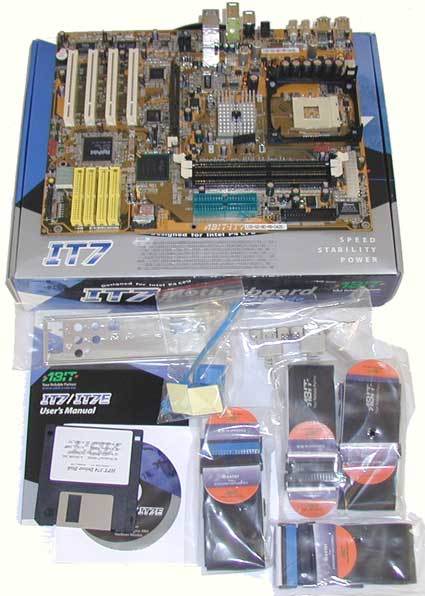Testing The E-Class: 9 Pentium 4 Motherboards With The 845E Chipset
The Boards
ABit IT7: Long Live Progress!
BIOS Version: 8H (6. May, 2002)
The IT7 has "less" technology to offer than its competitors - it's the first motherboard in our lab to lack PS/2 ports for the keyboard and mouse as well as serial and parallel ports. Although that may seem kind of shocking to begin with, you really no longer need any of these ports. Most people have had USB mice for a while now; even all the aging parallel or serial ports have had to make way for USB 2.0 or FireWire.
Since the antiquated ports have been eliminated, the IT7 (and the Intel board) boot in considerably less time than the competition.
One thing the IT7 isn't lacking in is ports - it has six (count 'em, six) USB ports on its connector panel. Then it also offers two additional ports, with an appropriate adapter cable included in the package. With all this, there's nothing stopping you from hooking up your printer, scanner, keyboard, mouse, digital camera, USB modem and joystick.
The network or DSL connection has been taken care of with a network controller from Realtek that can run at 10 or 100 Mbit/s. A sound system is also included, offering luxurious hardware surround sound and an optical digital port.
The powerful RAID controller is rather unusual - the IT7 is equipped with an HPT374 from HighPoint, which supports all IDE protocols right up to UltraATA/133 - and that four times over! Two hard drives can be attached to each of the four channels. Together with the IDE controller on the chipset (ATA/100), this translates into 12 ATA devices, which is a connectivity record among on-board systems.
Three DIMM sockets are available, allowing you to use up to 2 GB PC2100 DDR RAM (DDR266).
Get Tom's Hardware's best news and in-depth reviews, straight to your inbox.
The package contains a manual, a driver CD, three 80-pin IDE cables and a USB adapter, in addition to an ATX bracket. The latter was included because the port panel had been redesigned to make up for the lost ports. It goes without saying that the Abit once again provides an exceptional basis for overclocking - the CPU voltage, FSB speed and clock multipliers can all be easily adjusted in BIOS. Now, to discuss the small cloud in this silver lining - the IT7 provides only four PCI slots. That said, with all the important components already integrated, these expansion slots should be more than sufficient.
Current page: The Boards
Prev Page 845E - Not New, But Good Next Page AOpen AX4B Pro-533: Black Beauty
Patrick Schmid was the editor-in-chief for Tom's Hardware from 2005 to 2006. He wrote numerous articles on a wide range of hardware topics, including storage, CPUs, and system builds.

